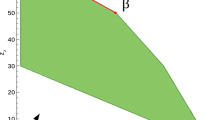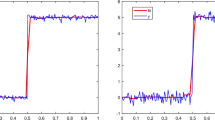Summary
We consider the problem of approximating an unknown functionf, known with error atn equally spaced points of the real interval [a, b].
To solve this problem, we use the natural polynomial smoothing splines. We show that the eigenvalues associated to these splines converge to the eigenvalues of a differential operator and we use this fact to obtain an algorithm, based on the Generalized Cross Validation method, to calculate the smoothing parameter.
With this algorithm, we divide byn the time used by classical methods.
Similar content being viewed by others
Rèfèrences
Ahlberg, J.H., Nilson, E.N., Walsh: The theory of splines and their applications. New-York: Academic (1967)
Chatelin, F., Lemordant, J.: La méthode de Rayleigh-Ritz appliquée à des opérateurs différentiels elliptiques, ordres de convergence des éléments propres. Numer. Math.23, 215–222 (1975)
Courant, R., Hilbert, D.: Methods of Mathematical Physics, New-York: Interscience Publishers (1953)
Craven, P., Wahba, G.: Smoothing noisy data with spline functions estimating the correct degree of smoothing by the method of generalized cross-validation. TR#445 (october 1977) University of Winsconsin-Madison
Fix, G.: Effects of quadrature errors in finite element approximation of steady state, eigenvalue and parabolic problems. In: Foundations of the finite element method with applications to partial differential equations. A.K. Aziz, ed. New York: Academic (1972)
Joly, J.L.: Théorèmes de convergence pour les fonctions spline générales d'interpolation et d'ajustement. C.R. Acad. Sci. Paris 264, ser. A. 126–128 (1970)
Laurent, P.J.: Approximation et optimisation. Paris: Hermann (1972)
Necas, J.: Les méthodes directes en théorie des equations elliptiques. Paris: Masson (1967)
Paihua, L.: Quelques méthodes numériques pour le calcul de fonctions spline à une et plusieurs variables. Thèse, Université Scientifique et Médicale de Grenoble Grenoble (Mai 1978)
Robert, F.: Analyse numérique itérative. Cours I.N.P.G. Grenoble (1974)
Stone, M.: Cross-validatory choice and assesement of statistical prediction. J. Roy. Statist. Soc. Ser. B,36, 111–147 (1974)
Sutti, C., One dimensional minimisation methods. In: Minimisation algorithms. G.P. Szegö, ed. London: Academic (1972)
Wahba, G., Wold, S.: A completely automatic french curve: fitting spline functions by crossvalidation. Commun. Statist.4, 1–17 (1975)
Wahba, G.: A survey of some smoothing problems and the method of generalized crossvalidation for solving them. TR#457 (July 1976) University of Wisconsin-Madison
Wahba, G.: Smoothing Noisy Data with Spline Functions. Numer. Math.24, 383–393 (1975)
Wahba, G.: Optimal smoothing of density estimates. TR#469 (october 1976), University of Wisconsin-Madison
Wahba, G.: Practical approximate solutions to linear operator equations when the data are noisy. SIAM, J. Num. Analysis.14, 4 (1977)
Weinberger, H.F.: Variational methods for eigenvalue approximations. SIAM, Philadelphia (1974)
Author information
Authors and Affiliations
Rights and permissions
About this article
Cite this article
Diaz, F.U. Sur le choix du paramètre d'ajustement dans le lissage par fonctions spline. Numer. Math. 34, 15–28 (1980). https://doi.org/10.1007/BF01463995
Received:
Issue Date:
DOI: https://doi.org/10.1007/BF01463995




